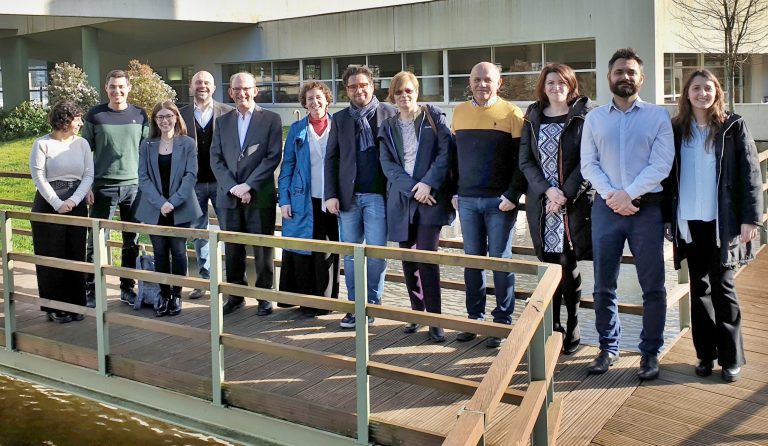The European Data Strategy and Digital Twins: Leveraging the Power of Data for Climate Change Adaptation
Accessible and interoperable data are at the heart of data-driven innovation and ecological transition. They are an essential source for the development of accurate digital twins – “a computer-generated version of a physical object, system, or person that is used to simulate and analyze how a real-world object responds to different environmental factors” (Global Satellite Services, 2023). Among their various applications, digital twins proved to be useful tools for effective environmental management. In particular, by simulating environmental conditions in a virtual space, digital twins can help us to better understand climate change and its impacts. For this reason, these digital models are now an essential component of numerous EU initiatives and projects focused on climate change adaptation, such as the RESIST project.
Empowering Europe’s Data-Driven Future: The European Data Strategy
In recent years, digital technologies have profoundly transformed all sectors of the European economy and society, impacting our lives in many ways. Data is at the center of this digital transformation: data-driven innovation is poised to deliver remarkable advantages to European citizens, for example through improved personalized medicine, new mobility, and by contributing to the European Green Deal. As we navigate this digital landscape, the European Union has the potential to emerge as a pioneering role model for a society empowered by data, enabling better decision-making both in the business realm and within the public sector. In a society producing an increasing amount of data, it has become imperative for EU policymakers to establish who can access them, and how they will be used.
The European Data Strategy is an EU strategic initiative aimed at establishing a unified data market, thereby ensuring Europe’s global competitiveness and safeguarding data sovereignty. To achieve this ambitious goal, the European Commission is building a new legal framework, governing the use and accessibility of data generated within the EU, encompassing all economic sectors.
One of the pillars of the European Data Strategy is known as the European Data Governance Act (entered into force in September 2023), which aims to leverage the potential of data for the benefit of EU citizens, businesses, and governments. The Data Governance Act promises to make more data accessible from various data owners (public sector, private sector, citizens) and sectors (e.g., mobility, environment, health), thereby enriching the data landscape. For example, the Act incorporates mechanisms that enable public sector entities to access and utilize data held by private enterprises under exceptional circumstances, such as crises like floods or wildfires.
Digital Twins: Modeling the Future of Climate Change Solutions
The increased availability of data enabled by the European Data Strategy has direct implications in a wide variety of fields. For example, access to quality data plays a pivotal role in enhancing digital twins. Digital twins are conceptualized as a computer-generated approximation of reality that can be continually refined with the addition of more data. Digital twins have emerged from the need to ensure that new solutions and innovations will perform as intended before their physical implementation. These digital replicas are assuming increasing significance in a multitude of domains, with relevance in understanding and managing the natural environment. Recently, the emergence of digital twins of the natural environment has been driven by the unprecedented volume of environmental data easily accessible from a vast and diverse range of sources. We can envision digital twins for various aspects of the natural environment, such as river catchments, focusing on issues like floods, droughts, and water quality. As these digital twins evolve and incorporate this wealth of data, they hold the promise of revolutionizing our approach to environmental management, making it more precise and effective.
One recent application of digital twins is the field of climate change. Digital twins can model how different climate change scenarios will impact societal and environmental systems in the real world. These digital models and predictions can help us develop more effective, targeted and financially-sound climate solutions and strategies. Digital twins can also be used for communication and awareness-raising purposes since they can visualize different climate change scenarios and adaptation solutions. In this way, they can bring citizens and interested parties closer to the solutions being implemented and generate a sense of ownership.
As a result of this significance, digital twins are getting increasingly more attention from European institutions and have been deployed in various initiatives and projects. One example is the Destination Earth initiative (DestineE), which aims to develop a highly accurate digital model of the Earth on a global scale. The model will monitor, simulate, and predict the interactions between natural phenomena and human activities. Thanks to this initiative users can access and interact with vast amounts of Earth system and socio-economic data to exploit and test their own models.
RESIST: Digital Twins in action
Digital Twins are also being developed within the Horizon Europe-funded RESIST project, to which Startup Europe Regions Network is a partner. The RESIST project is implemented in the context of the Mission Adaptation to Climate Change, which aims to support EU regions, cities, and authorities in their efforts to build resilience against the impacts of climate change. The project is testing adaptation solutions to five key climate change challenges (floods, droughts, heatwaves, wildfires and soil erosion) in 12 regions. The purpose of digital twins’ application in RESIST is to visualize different climate scenarios and adaptation solutions in specific regional contexts. RESIST is making use of digital twin technology to help the partner regions overcome their climate change-related challenges by rigorously testing new innovative solutions before bringing them to the market. By using digital twins, RESIST stakeholders can engage with these solutions and avoid unnecessary costs and improve outcomes when they are applied to reality.
Furthermore, Digital twins will be used to share results with external private stakeholders. SERN, leveraging its experience in startup involvement, will play a pivotal role in bringing the private sector perspective into the project. Specifically, SERN’s role is to promote active collaboration between the regions and their stakeholders, and actors in numerous innovation ecosystems across EU and beyond. SERN’s strategy involves organizing webinars and facilitating external missions, thus creating a knowledge sharing platform to attract innovative startups eager to further develop towards the market the most promising CCA innovations.
Giorgio Alessandro
Project Manager
______________________________________________________________________________________________________
References
- European Commission (2020). A European Strategy for Data
- https://www.21cconsultancy.com/post/the-data-governance-act-practical-implications-for-digital-twins
- Global Satellite Services: https://ts2.space/en/the-benefits-of-digital-twins-for-environmental-monitoring/#gsc.tab=0
- EU Mission: Adaptation to Climate Change: https://research-and-innovation.ec.europa.eu/funding/funding-opportunities/funding-programmes-and-open-calls/horizon-europe/eu-missions-horizon-europe/adaptation-climate-change_en
- DestinE website: https://digital-strategy.ec.europa.eu/en/library/destination-earth
- RESIST project website: https://resist-project.eu/






